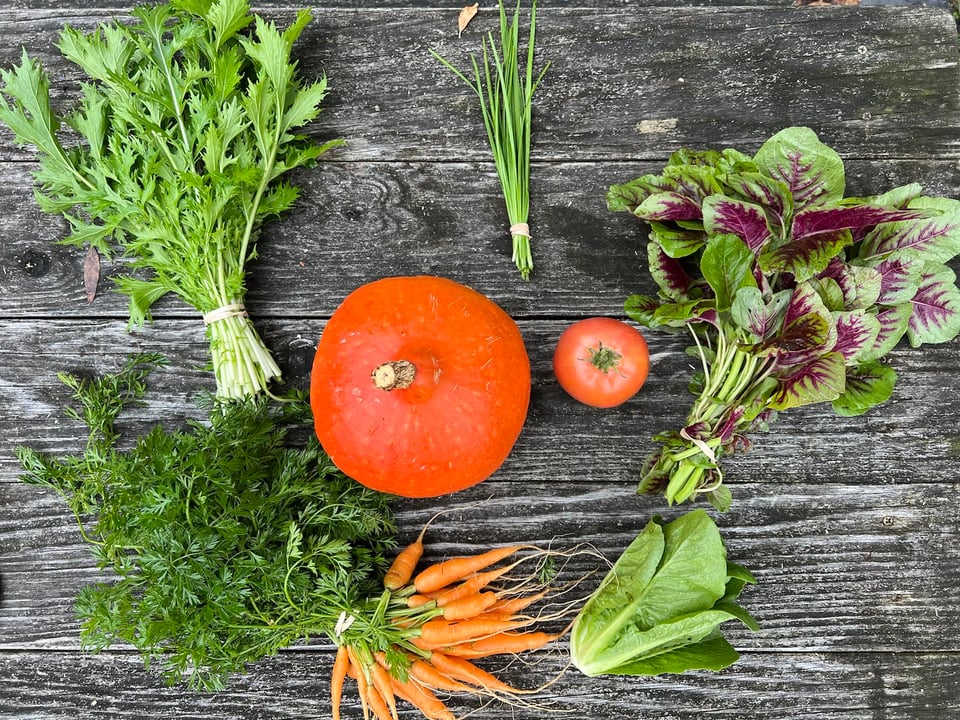CSA Week 19: The Wild World of Winter Squash

Farm Share Newsletter - October 15, 2023

This Week's Share:
Mizuna
Garlic Chives
Red Kuri Squash
Tomato
Amaranth
Carrots
Mini Romaine
Eat Winter Squash!
When the air begins to bite with cold and the smell of decaying leaves, the colors and tastes of what we eat begin to deepen. - Katrina Vandenberg, Orion Magazine, September/October 2010
It's a strange feeling, transitioning to another mode of being. Elizabeth and I are both spending far more time doing non-farming work these days, even as we continue coiling drip tape and planning for the next season. A far cry from the week-to-week overtime in the fields.
We like it this way. I like to imagine sometimes that we could relate to teachers, though they get to enjoy the summer as the off-season. Our work is still work, but it's less physically demanding. My back already feels relieved.
I believe we have kept up our streak of at least one new veggie per share, and I'm confident we'll end the season batting 1.000. We have tried to grow garlic chives since our first season in 2021. As a perennial with an exceptionally long growing season, it has proven way too difficult to keep up with the weeding. Also, in the past, we have accidentally grown western chives. This season, our garlic chives are small, but it's been our most successful crop yet. Next season, we'll figure out a way to battle the weed pressure. Perhaps some straw or woodchip mulching.
By the time Elizabeth and I apprenticed at Persephone Farm during the first COVID summer and fall, I was unfamiliar with winter squash. Canned butternut, roasted with marshmallow crust, dished by my mom in middle-age as she adopted Thanksgiving as her own tradition, was as far as I explored. That, and spaghetti squash (an abomination). At Persephone, I was awakened to a new world. Persephone's founder, the late Jeff Falen, grew at least a dozen varieties, covering at least an acre with their prickly vines.
We harvested them all at once as the leaves turned. Of all the harvests, winter squash required the most athleticism. One of us would drive Jeff's Kubota, parking and moving forward a few meters at a time as we all filled a harvest bin on the tractor's forklift. We would start by severing every squash from its vine with loppers. Two of us would stand by the bin while the rest of us would toss them squash for storage. Some, like acorn squash or delicata, could be spiraled like footballs. Others medicine ball-esque big boys, like kabochas or hubbards, required two-armed, underhand lobs. I have no idea how many squash we ended up tossing over the course of two or three days, but it must have been in the thousands.
For about a month, we had winter squash with almost every meal. Persephone co-owner and Jeff's widow Elanor O'Brien, would simply cut each squash in half and toss them in the oven, seeds and all. She'd serve us each a half-squash, which could be a meal by itself. We all adopted this method. We had delicatas, acorns, tetsukabutos, butternuts, buttercups, candy roasters, and, regrettably, spaghettis. But my absolute favorite discovery that season was red kuri. They don't store as well as tetsukabutos, and they're not as easy to work with as delicatas, but they have the most nuanced flavor and creamiest texture. I regret not growing more this season. Here's a recipe from Bon Appétit, if you have the patience. For faster results, try Elanor's method: Heat your oven to 400F. Cut your kuri in half. Glaze your flesh with olive oil. Sprinkle salt. Place flesh-down. Cook until butter-knife tender. Check first after 20 minutes, and every 10 minutes after that. Enjoy, skin and all (but discard the seeds).
One evening, Elanor shared with us the article I quoted from above, "On Cold-Weather Vegetables" by Katrina Vandenberg. I love it so much that I'll quote from it twice:
Gnarled sweet potatoes, tips curling like the feet of witches. Hubbard squashes, big enough to sit on, warty, blue. Mushrooms flaring their gills. Back in July, the tomatoes and corn the farmers offered were cheery, Crayola-bright. October is scary: it holds out every child’s most despised vegetable in its wrinkled claw.
Cold-weather vegetables are demanding. They require a little muscle behind the knife, and their hard shells can’t be sliced as much as hacked at. Inside, their flesh is richly colored and dense. They’re messy: eviscerate is the word that best describes how we scrape stringy flesh and seeds from a pumpkin to ready it for carving. We wrestle with them. They refuse the ease of the salad bowl and insist on a long roasting.
'Til Next Week,
Steven
